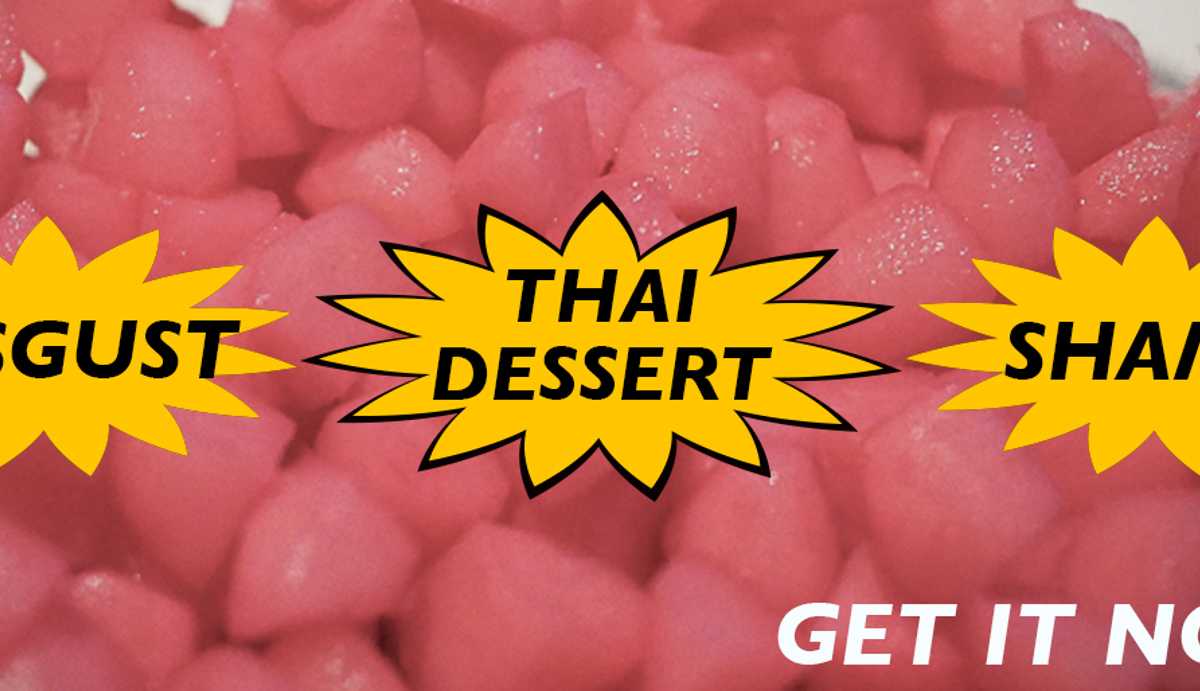Ingredients: Coconut jelly, coconut slices, half and half milk, jack fruit, sweet red syrup, tapioca flour, water chestnuts My mom’s version of Tup Tim Krob is one of my favorite Thai desserts, an odd combination of water chestnuts and fruits in a creamy milk that somehow becomes a delectably perfect dish. I have savored every bite since childhood, as the recipe morphs into a dish I consume so very rarely in my life, always reserved just for special occasions. I particularly relish the coconut jelly slices – how each smooth cube releases a small bit of joy with each chew. Despite the sense of childlike glee I have whenever a bowl of Tup Tim Krob is in my hands, it also conjures up a sad and powerful memory I can never forget. Every child lives through a moment, an incident where their differences from others are highlighted amidst a chorus of hurtful mockery and laughter. My first memorable encounter of being “the Asian kid” with the weird culture begins in the first grade. A few days before the incident, my teacher announces that she’d like each student to bring in a dish reflecting their heritage and family background. In my five-year-old mind, I jumped up and down because I knew the exact dish I wanted to present to the class: Tup Tim Krob. It was different, it was sweet, so surely my peers hooked on candy and ice cream would enjoy my Thai dessert. Upon telling my parents excitedly about the assignment, they smiled, as they must have seen the eagerness in my face. I looked on with delight in the kitchen as my dad chopped the jackfruit while my mom prepared to soak the water chestnuts in the sweet red syrup known as “naam daeng”, or literally translated, “red water”. After all the ingredients were stirred together the following evening, I was able to convince my mom to pour me a small bowl before I had to bring the dish to school. I ate my serving of Tup Tim Krob with the intensity of a thirsty kitten lapping up milk. Presentation day arrived, and I began proudly introducing my dessert. The students’ bowls were filled up and I anxiously awaited their smiles and words of approval. Instead, I heard “blech” and “ewww”. The majority of the class disapproved of the dish I lovingly cherished, and I watched helplessly as I saw my parents’ hard work ending up in the trashcan, one bowl at a time. A part of me wanted to cry, and another part of me was angry. How could my friends, my classmates, so quickly reject the dessert I love so much? I felt a pain I had not remembered experiencing before. The sense of rejection and the disdain challenged my culture, my upbringing, and my identity. I returned home after school with my head down, like a dog with its tail between its legs. I told my parents about what happened, and they comforted me. “It’s alright” and “they don’t understand” were the two repetitive phrases of the night. I was temporarily consoled, but the event was permanently seared into my memory. Fortunately, the passage of time has allowed me to contextualize the event as one of the first moments in my life where I’ve been confronted about my identity, challenged on my sense of belonging in the United States, the country of my birth. While I had no idea that I was going to confront cultural (and culinary) ignorance, let alone having to comprehend such terms on an emotional level as a five-year-old, I would gradually come to learn that living such experiences lead to a greater understanding of myself and my cultural identity. To echo the Dutch ethnographer Arnold van Gennep, I had reached a liminal period in the great ritual towards adulthood, where I had to renegotiate my values and identity in order to better understand myself. I also discovered that I wasn’t alone. In my high school and university years, I found friends and classmates who shared similar stories about their own cultural and racial struggles. We all had our own Tup Tim Krob stories, and thus formed a sense of communitas, coined by British cultural anthropologist Victor Turner to describe a sense of community and belonging outside traditional social structures. Thankfully, the world changed with us, as suddenly Western culinary palettes became more adventurous and appreciative of non-Western cuisines. Thai restaurants can now be found on main streets across the US, and Thai menus are present in American mailboxes and mobile phone takeaway apps, although Tup Tim Krob remains difficult to find. In due time, perhaps. Food is often considered a gateway to understanding a culture, and I have seen firsthand the dynamic social relationships that can form through the simple act of sharing a meal. I don’t regret sharing Tup Tim Krob with my classmates, and this one bad childhood memory has never stopped me from enjoying it. I now consider each bite a form of resistance, each helping a reaffirmation of who I am and where my family comes from, and my bad memory a reminder of the discrimination I faced growing up as an Asian American and, specifically, a Thai American. I understand now the sociocultural complexities and the individual struggles involved in forming one’s identity, particularly as a member of an ethnic minority from the US. Though I am still disheartened that my classmates did not enjoy the Tup Tim Krob, I’m glad that I introduced them to a new food dish, challenging their cultural norms, their status quo. I have an inkling that many of my old first grade classmates would appreciate and even enjoy Tup Tim Krob as adults today. I never thought that a dessert I treasured would help me understand the importance of facing discrimination early on in life, or spark such a visceral and bittersweet memory. Even so, I’ll eat on.
Thai Dessert and Bittersweet Memories

How a crisp pomegranate dessert became the gateway for cultural understanding and self reflection


